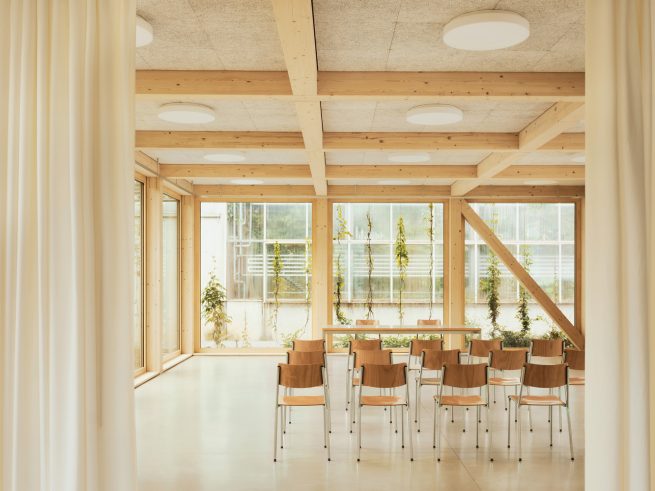
The ceiling is an important element in architecture and interior design, combining functionality with aesthetics through different materials that add layers of texture and color, providing quality and comfort in interior spaces as well as a protective surface for other building systems.
In 2014, the 14th International Architecture Exhibition of the Venice Biennale, titled Fundamentals, directed by architect Rem Koolhaas, explored the fundamental elements of architecture and the evolution of these components through history. The Central Pavilion welcomed visitors with a comparison between a ceiling from the Renaissance and the ceilings of contemporary architecture.
While the 16th-century representation shows a more organic form and a painting reminiscent of Italian frescoes, the contemporary ceiling panels are like a functional layer to hide the growing network of pipes and ducts of the more recent architecture.

Ceilings are often not emphasized in architectural projects, but they have important features that can be incorporated into the design, such as thermal and acoustic properties and their function as protection for building systems. For example, the Jordão House / FGMF Arquitetos uses wood paneling on the vaulted ceiling, creating a sense of openness and space while at the same time creating a layer of air between the roof and the interior, acting as thermal insulation, which is a great solution for the local climate.

Another key feature of ceilings is their noise reduction properties. Some ceilings are made with acoustic materials that can absorb sound, making the interior space more comfortable. At the Captaincy Office / Canoa Arquitetura, the ceiling panels fit into the frames created by the concrete beams, highlighting the pattern of the building’s structure. The Torremuelle Apartment / Estudio Primitivo González opts for covering the entire ceiling with acoustic panels, left exposed. The Sony Music Entertainment Amsterdam / Space Encounters uses a different strategy, applying the acoustic ceiling panels behind another ceiling, a steel grid that serves as both a protection for the equipment on the ceiling and a device to conceal these components.

Another advantage of ceiling panels, especially in vertical construction, is protecting the plumbing systems throughout the building. In apartments, for example, it is usual for wet areas such as kitchens, laundries, and bathrooms, as well as circulation spaces, to have ceiling panels because building systems such as plumbing, electric power, air-conditioning, fire alarm and fire suppression systems, etc, often run through these areas towards the building’s pipe shafts. These ceilings are normally made of plasterboard and can be used as decorative elements, combined with lighting and other objects, like in the NAJ Apartment / Triplex Arquitetura, which uses the plaster ceiling to hide the curtain tracks, for example, and also features wood ceilings in other rooms of the apartment, protecting the ventilation and lighting systems.

The interior design project for the Cooperative Business Headquarters / DA | Departamento de Arquitetura demonstrates how the functionality and aesthetics of ceiling systems can be combined in one single environment. The ceilings were strategically designed to achieve quality workspaces, with good ventilation and acoustic comfort, while some spaces feature plasterboard ceilings with recessed artificial lighting, sprinklers, and exhaust fans, other spaces are marked by hanging elements combined with lighting creating a more sculptural effect.
Vía Archdaily




